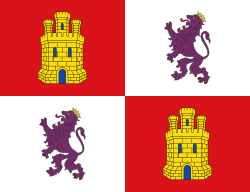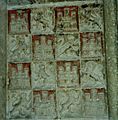Castile and León facts for kids
Castile and León (Spanish: Castilla y León), known formally as the Community of Castile and León, is one of the 17 autonomous communities of Spain.
Images for kids
-
Skull number 5 of Homo heidelbergensis, it appeared in the 1992 campaign, extracted from the Atapuerca Mountains.
-
Bulls of Guisando, in El Tiemblo, Ávila. These verracos, of Celtic origin, are found in many towns of the western half of Castile and León.
-
Aqueduct of Segovia, Roman construction.
-
Castle of Gormaz. It was the largest fortress in Europe after its expansion in 956, in the river Duero defense line.
-
Pantheon of kings of the Romanesque Basilica of San Isidoro of León where Alfonso IX convened the Cortes of León of 1188, the first parliamentary body of the history of Europe, with presence of Third Estate. In the same basilica is the Chalice of Doña Urraca, which some researchers assimilate with the Holy Grail.
-
In Tordesillas queen Isabella I of Castile signed the Treaty of Tordesillas. Her daughter queen Joanna of Castile was imprisoned in a convent of the city by her father first, by her son later, and was praised by the comuneros in their Revolt.
-
Conventual Church of San Pablo and Colegio de San Gregorio, where the Valladolid debate was held, origin of the first theses of human rights (Laws of Burgos) and Palace of Pimentel, place of birth of the king Philip II of Spain.
-
The Douro on its way through Zamora.
-
La Alberca, Sierra de Francia.
-
La Covatilla Ski Resort. The Sierra de Béjar is one of the wettest areas of Castile and León next to the Sistema Central Mountains.
-
Canal de Asotín Beech, a UNESCO World Heritage Natural Site.
-
Orbaneja del Castillo village in the Hoces del Alto Ebro y Rudrón Natural Park.
-
Arribes del Duero Natural Park, which is a special protection area for birds.
-
Castile and León is the main habitat of the Iberian wolf. The naturalist Félix Rodríguez de la Fuente promoted the protection of the species.
-
Western Spanish ibex, also called Gredos ibex (Capra pyrenaica victoriae), indigenous to Sierra de Gredos.
-
Part of the Reserve of European bison in San Cebrián de Mudá, Province of Palencia.
-
Calle Mayor street of Palencia. The city is within the most dynamic axis of the community.
-
Villarejo de Órbigo, typical rural town of the Ribera del Órbigo and of Tierra de Campos comarcas.
-
The Meseta Central is a large plateau ranging a considerable part of the region of Castile. In the image a landscape of the Meseta Central viewed from the castle of Gormaz.
-
Morucha cow in a dehesa of Campo Charro, place of production of Jamón de Guijuelo.
-
Pines in Valle de Valsaín.
-
Renault factory in Valladolid
-
Segovia is one of the main receptors of tourism in the region, world heritage city as well Salamanca and Ávila.
-
Las Médulas. A world heritage site, the landscape is the result of Roman mining techniques in what it was a gold-rich area in Antiquity.
-
Façade of the University of Salamanca in which Francisco de Vitoria created the School of Salamanca and international law.
See also
 In Spanish: Castilla y León para niños
In Spanish: Castilla y León para niños













































